What is the diameter of the world's largest single convex lens? What image does a convex lens form?

|
In optics, the image formed by the convergence of actual light rays and can be displayed on the screen is called a real image; the image formed by the convergence of the reverse extension of the light rays and cannot be displayed on the screen is called a virtual image. So today, let's go to the Encyclopedia Knowledge Network and learn about what kind of image a convex lens forms? I hope it will be helpful to you. Contents of this article 1. What is the diameter of the world's largest single convex lens? 2. What image does a convex lens form? 3. When does a convex lens form a clear image? 1What is the diameter of the world's largest single convex lens?1. Currently, the world's largest optical astronomical telescope is the Keck telescope on Mount Mauna Kea in Hawaii, which was put into use in 1993. The aperture of its main lens reaches 10 meters. 2. The Keck telescope is located on the Pacific island of Hawaii, on the rarely visited Mauna Kea at an altitude of more than 4,200 meters. It was built by the University of California, Berkeley, Lawrence Berkeley National Laboratory and California Institute of Technology. 3. The atmosphere on Mauna Kea is very clean, and the weather is clear most of the time. Many world-class telescopes are concentrated here. The Keck Telescope is one of the largest telescopes in the world, costing $130 million, mainly donated by American entrepreneur Keck. 2What does a convex lens form?Convex lenses form real images. Convex lenses are made based on the principle of light refraction. Convex lenses are thicker in the center and thinner at the edges. Convex lenses are divided into double convex, plano-convex and concave-convex forms. Convex lenses have the function of converging light, so they are also called converging lenses. Thicker convex lenses have the functions of looking far away and converging, which is related to the thickness of the lens. Hyperopia glasses are convex lenses. Convex lenses, like concave lenses, do not have a definite focus. Only light rays that are parallel to the main optical axis and at equal distances from the main optical axis will completely intersect on the main optical axis. The reason why many light rays that are parallel to the main optical axis but at unequal distances from the main optical axis passing through a convex lens have a "focus" is because the radius of curvature of the convex lens is large, and the difference in the degree of light deflection is not obvious. 3When does a convex lens form a clear image?When forming a clear image, there is a certain quantitative relationship between the image distance, object distance and focal length: 1/f=1/u 1/v. When adjusting the imaging, the image will be the clearest only when the focal length, object distance and image distance are adjusted to conform to the above rules. The law of image formation by convex lens is an optical law. In optics, the image formed by the convergence of actual light rays and can be presented on the screen is called a real image; the image formed by the convergence of the reverse extension of the light rays and cannot be presented on the screen is called a virtual image. When the object distance is greater than 2 times the focal length, the image distance is between 1 and 2 times the focal length, forming an inverted, reduced real image. At this time, the image distance is smaller than the object distance, the image is smaller than the object, and the object and the image are on opposite sides. When the object distance is equal to 2 times the focal length, the image distance is also equal to 2 times the focal length, forming an inverted, equal-sized real image. At this time, the object distance is equal to the image distance, the image and the object are equal in size, and the object and the image are on opposite sides. When the object distance is less than 2 times the focal length and greater than 1 times the focal length, the image distance is greater than 2 times the focal length, forming an inverted and enlarged real image. At this time, the image distance is greater than the object distance, the image is larger than the object, and the object and the image are on opposite sides. When the object distance is equal to 1 times the focal length, no image is formed and the light is emitted as parallel light. When the object distance is less than 1 times the focal length, an upright and enlarged virtual image is formed. At this time, the image distance is greater than the object distance, the image is larger than the object, and the object and image are on the same side. |
<<: What is the law of imaging with convex lenses?
Recommend
What are the symptoms, causes and treatment of mucopurulent cervicitis?
Mucopurulent cervicitis is a relatively common gy...
What are the dietary health care for pink vaginal discharge?
Leucorrhea is a normal physiological characterist...
How to treat amenorrhea at the age of 45
Women will have many abnormal physiological needs...
National Safe Medication Month丨Confessions from the Dihuang Pill Family
Liuwei Dihuang Pills It is derived from the Shenq...
Can congenital uterine malformation affect fertility?
The uterus is one of the female reproductive orga...
What should I do if I have vaginal discharge caused by vaginitis?
Many women have recently developed vaginitis, wit...
What causes vaginal pain?
The vagina is a very important reproductive organ...
The harm of leg clamping during menstruation
Women's physical health is very important for...
Osteoporosis in the elderly should not be ignored
Author: Wang Changyuan, Chief Physician, Xuanwu H...
Ten things to be careful of when having a healthy uterus
The uterus is not only an organ that nurtures the...
Fingers itchy and blisters after getting manicure
Doing manicures is a relatively long process. If ...
How to regulate dark period color
Many people experience dark-colored menstrual dis...
What are the sleeping positions for pregnant women?
What sleeping positions are suitable for pregnant...
Can I drink carrot juice during my period?
As we all know, menstruation is closely related t...
What should women eat to have a good complexion and rosy skin?
For mature women, they experience a menstrual per...









